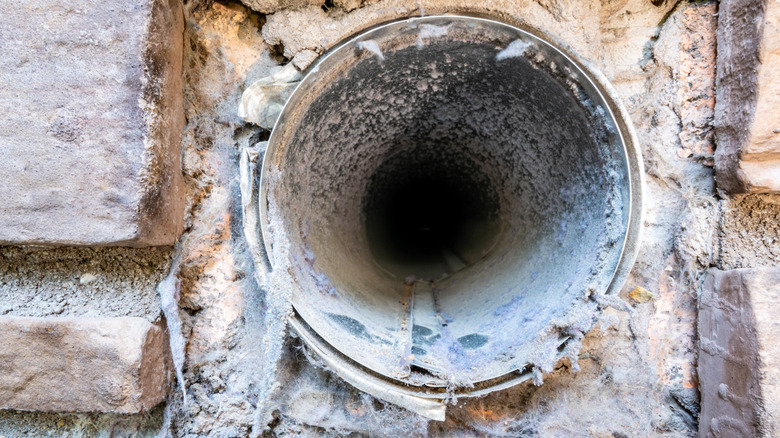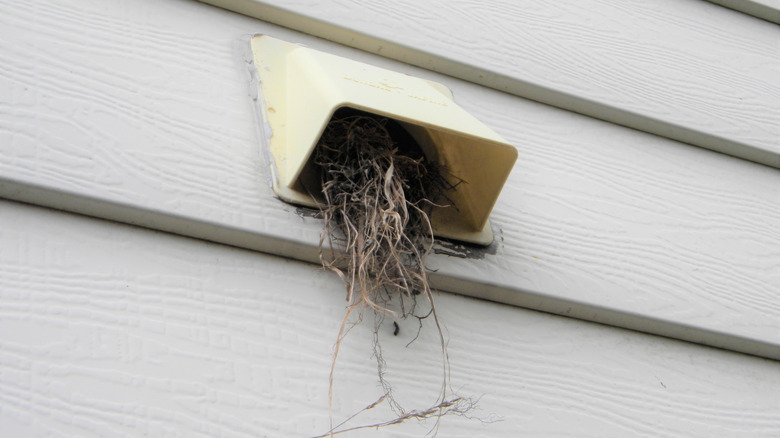The Hidden Danger Lurking In Your Dryer Vents
Always clean your dryer lint. It's one of the big household lessons you likely learned back in the day, when you first got the hang of doing your own laundry. (And whether that was as a kid or a young adult, we're not judging.) It's one of those laundry rules that's high up on the list, right after separating your darks and your whites.
A dryer's lint trap — the small filter that gathers loose lint during the drying cycle so it doesn't stick to your clothes — is not the same as a dryer vent, which is a common misconception. JoeFilter.com calls the trap "the first line of defense." Whatever debris it doesn't collect is then sent back into the vent, which — you guessed it — has to be cleaned, too. A dryer vent, also known as a duct, is the exhaust system that directs any of the uncaught debris outside of your home.
Before you skip adding this chore to your to-do list, listen up: Cleaning your dryer vent is actually crucial — and for reasons that may just get you up and moving, no matter how badly you want to skip cleaning day. Even if you've religiously cleaned the lint trap between each and every last load, there are some hidden dangers you may have never considered waiting in your dryer vent.
A dryer vent blockage could spark a big problem
Of course, not cleaning your dryer vent leads to one obvious problem: A blocked vent equals poor airflow, which means a half-damp and wrinkled load of laundry. But what's even worse than redoing a whole load of clothes is the risk posed by a neglected dryer vent.
Lint can build up quickly in the vent, forming a blockage so thick that it can get caught in the heating element. It can also be mixed up with other debris, like grass, dryer sheets, or old paper from clothes' pockets. All of the above items are highly typical — and highly flammable. Between 2014 and 2018, fire departments encountered an estimated 13,820 house fires in the United States that stemmed from a single location: the dryer (via NFPA). Nearly one-third of these fires were caused by lint buildup in the dryer vent.
The Building Performance Institute recommends cleaning your dryer vent once at least every three months, with a more thorough cleaning every six months. Keep an eye out for unusual smells, damp or burning hot clothes after drying, and extra lint around the edge of your door between loads. If you encounter these issues, chances are your dryer vent needs to be unclogged before things get a whole lot worse.
Beware of gas buildup from your dryer vent, too
Believe it or not, but a blocked dryer vent doesn't just pose the risk of fire — carbon monoxide is a major threat, too. If the airflow of the vent is obstructed, carbon monoxide can build up and be pushed back into your home, leading to a poisonous gas situation. Since carbon monoxide is odorless and colorless, this scenario could be fatal if not properly prevented (via Dryer Vent Wizard).
The problem here isn't just lint, either. If you live in a particularly woodsy area or your dryer vent is particularly exposed to the outdoors, animals could interfere with your dryer's exhaust system. Birds, especially, tend to build nests in dryer vents, which can contribute to a lack of air circulation and carbon monoxide leaking into the home, per Regional Wildlife Services. The best way to prevent that problem and protect birds? Opt for a covered dryer-duct system, which will automatically close when it's not in use.
While the hidden dangers of a dryer vent can be nerve-wracking for any homeowner, there's truly nothing better than a fresh, warm load of laundry (at least, until you have to fold it). So, keep using your dryer like normal. Just don't ignore the dryer vent.


